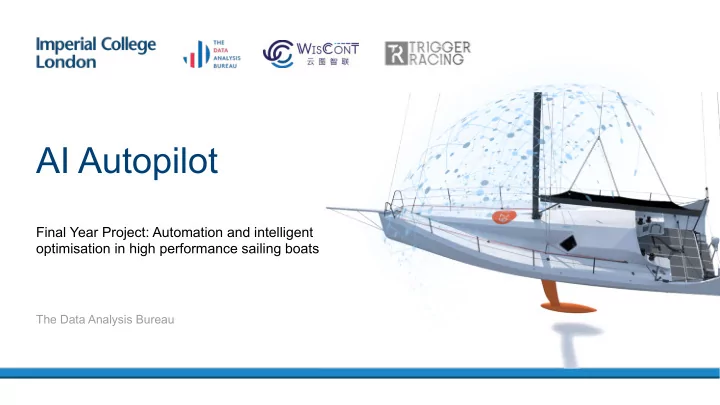

AI Autopilot Final Year Project: Automation and intelligent optimisation in high performance sailing boats The Data Analysis Bureau
Project Introduction • Machine Learning approaches to the Helmsman problem – Controlling the rudder input based on recorded data • Jack Trigger data collected from onboard sensor- and processing system (NKE systems) • Various data formats and additional data sources • A problem split into the domains of: – Control theory – Data science [1] Jack Trigger Racing, www.triggerracing.com – Applied machine learning – Eventually IoT
Background and previous work Background and motivation: • Recent explosion in the development of ML for the purpose of autonomous driving and other applications • A desire to transfer recent developments in methodology and toolboxes to the realm of high performance sailing • Within high performance single-handed sailing: The desire to emulate a human driver and outperform existing, traditional autopilots Skype conversation with Dr. Pieter Adriaans
Data Sources Adrena Export: .csv Sensor Array Topline Bus NKE Proprietary: .NKZ Processor HR NMEA-0183: .LOG (txt) BoxWifi
Data Sources .NKZ => .csv .csv • 32 files • 17 files • 188 (~50) features • 41 features • 16 hours • ~200 hours • 25 Hz • 1 Hz • Rudder data • No rudder data • Pilot data • No pilot data
Aim: Alleviate the workload of a solo sailor and optimise Velocity Made Good (VMG), rather than just keeping course Two different approaches to the same problem: • Reinforcement Learning • Supervised Learning
Reinforcement Learning Rate of convergence to Rudder the desired location action angle Goal Wind Agent Environment Boat Sea state reward Start
• Wind Agent ENVIRONMENT Sea Input • Sea State (Actor) (real) State • Location State Rudder VMG Angle Database Dynamic Model of • Velocity BOAT the Boat • Orientation (model) (Critic)
LSTM – Long-Short-Term Memory Neural Networks LSTM consist of memory blocks called cells. Each cell has three gates: 1. Input gate – which information is useful at this particular level 2. Forget gate – which information is no longer relevant and could be forgotten. Allows for long-term memory, so history of 3. Output gate – what information boat dynamics can be included in the is relevant for the next cell estimation of the next state.
... t-3 t-2 t-1 t t+1 Wind Boat Orientation Current Boat Position LSTM Boat Orientation . Boat Position Boat Speed . . . Boat Speed . . . Control Action . .
• Wind Agent ENVIRONMENT Sea Input • Sea State (Actor) (real) State • Location State Rudder VMG Angle Database Dynamic Model of • Velocity BOAT the Boat • Orientation (model) (Critic)
• Wind ENVIRONMENT Sea Input LSTM • Sea State (real) State • Location Rudder Angle Database
... t-3 t-2 t-1 t Wind Current t+1 Control Action LSTM Boat Orientation Boat Position . Boat Speed . . . Control Action . .
Rudder Angle
Moving to the Cloud
Future: Edge Computing
Recommend
More recommend